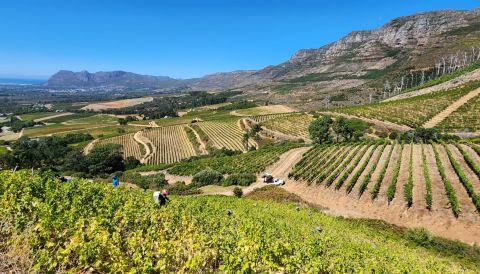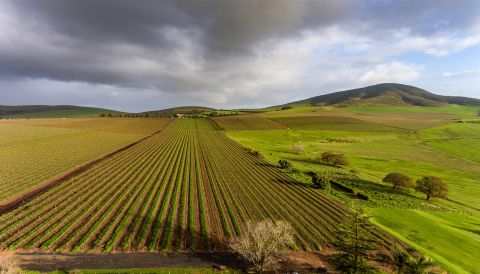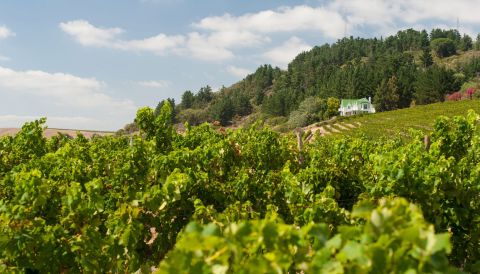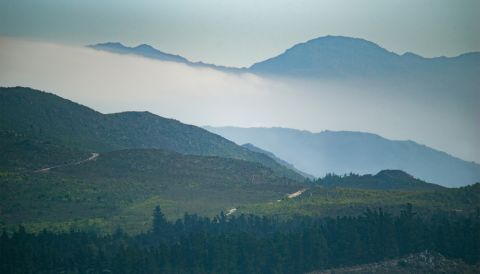‘A paradox’, says viticulturist Etienne Terblanche when asked to sum up the 2024 South African harvest. ‘We had cool and wet conditions leading up to the vintage, culminating with the disastrous flooding at the end of September’, elaborates the head of consultation services at Vinpro, South Africa’s generic wine organisation.
His comment is in reference to the extreme flooding in the Western Cape, which not only damaged infrastructure across the province, but put many vineyards under water, too. ‘Though’, Terblanche adds, ‘the soils that tend to be marginal had a great run this year in terms of quantity and quality.’ As an example he cites the Olifants River area. ‘The sites on the alluvial riverbed were seriously impacted, but the further you move away from the river the soils become more brackish with clay and rock, and the red varieties did fantastically this year.’
In fact, the majority of South Africa’s wine-growing regions benefited from an excellent winter, with plenty of cold spells enabling a good dormancy period while the above-average winter rainfall replenished dams and groundwater reserves. Viticulturist Jaco Engelbrecht, who consults for many producers, among them Eben Sadie, points out that, while the winter was wet, it was not as cold as the previous year, and there was very little snow in the Witzenberg, Ceres and Matroosberg mountains. Spring was ‘quite warm’ and this progressed: ‘to become a hot and very dry growing and ripening season. ‘Wind was a constant from this point on. This, together with the warm weather, made the vines grow like mad, as they had a full water tank and were constantly transpiring.’
Terblanche points out, however, that there were marked differences between coastal and inland regions. The harvest came on faster along the coast, in places such as Robertson, Breedekloof and Montagu. ‘On the back of the cool and wet 2023 vintage, 2024 was definitely early in the coastal regions and many are down on yields.’
He adds that because of the wet conditions, the main challenge of the season was the early varieties, such as Chardonnay, Pinotage and the early Chenins (coastal), which budded earlier and cropped lower than the later varieties.
‘The back end of the season was moderate to warm and dry, unlike the 2023 harvest where we struggled to ripen the later reds. Disease pressure has also been consequently low. The later season this year has made up for the losses of the first half.’ In fact, Terblanche adds, ‘Sauvignon Blanc crops were up in many cases. Both Durbanville and Darling had a great vintage, as did the areas with later-ripening reds.’ The Orange River area is also on track for recovery despite some hail damage during the festive period, he reports.
Coastal region highlights
Cape Town
Elunda Basson, winemaker at Steenberg Estate, says 2024 was one of the earliest vintages in decades for Constantia, with most wineries reporting a start 10–14 days earlier than usual. Basson affirms that early varieties like Chardonnay were down on yield, while Sauvignon Blanc was up.
At Klein Constantia, viticulturist Craig Harris recalls, ‘‘No one thought water would be an issue, but thanks to weeks of south-easterlies drying the environment we started the harvest under water strain. This meant weak patches had to be harvested early to avoid stress and it made for a season of running from block to block picking ideal areas.’ The Vin de Constance harvest, which usually stretches into the middle of April, finished at the beginning of the month. ‘The Muscat enjoyed the dryer season – we saw a beautiful balance of raisin to fresh berry bunches’, he says.
In nearby Noordhoek on the other side of the Constantiaberg, winemaker Riandri Visser also experienced an early harvest. ‘We wrapped up on 1 March, three weeks on 2023. We observed riper sugar levels early in the season, coupled with low pH and high acidity levels. We knew we had to move fast to preserve the acidity.’
Charles Hopkins of Durbanville estate De Grendel highlights wind as an issue, especially during flowering. ‘Some wineries and growers have reported a 30–50% loss in crop, largely with Chardonnay and Pinot Noir.’
Harvest for Durbanville contemporary Diemersdal began 10 days earlier than in 2023. ‘The lack of surface moisture in the soils led to grapes reaching ripening levels earlier’, comments Thys Louw, sixth-generation winemaker and owner of the farm. But, he says, crop and quality are up. For varieties such as Cabernet Sauvignon, Shiraz, Merlot and Malbec he says the warm period boosted sugar levels and fruit flavour as well as tannin and anthocyanin accumulation.
The heartland
‘We have had a season of extremes this year’, observes Christo Le Riche of the eponymous winery in Stellenbosch’s Helderberg. ‘Our spring was disastrous, with the record-breaking downpours and strong winds. Fortunately, the Cabernets had not started budding.’
Not all escaped unscathed, he says – they did have a few early blocks which suffered wind damage from the last storm in early October. Le Riche calculates that the magnitude of the wind was 26% higher than in 2023, which led to a small crop. The season also came early to Stellenbosch, with the second-highest GDD (growing degree day) count in the last 10 years. ‘Harvest kicked off fast and furious. Colour and flavour development has been outstanding, with small, concentrated berries.’
Gary Jordan, who just marked the 32nd vintage at Jordan Wine Estate, his Stellenbosch Kloof farm, sums up 2023: ‘It has been very different from all the others!’ They received 69% more rain than in the preceding harvest year 2022/23, and the average growing-season temperature was 19.2 °C (66.6 °F), which is warmer than usual. Rather than using tractors in the wet vineyard blocks, which would compact the soil, the Jordans employed a drone to spray for fungal diseases. ‘This was a game-changer and ensured that mildew was kept at bay at a crucial time.’ Fine vine roots were also a concern as they are essential to stop the early onset of drought stress, Jordan says. ‘The root zone around the grapevine becomes saturated and the air between the soil particles is replaced by water. When plants are growing actively (as they were prior to the 25 September storm), fine root tips begin to die within a few days of waterlogging. The restricted root system that then develops limits the uptake of nutrients, particularly nitrogen, and water. The uptake of other nutrients such as phosphorous and calcium can also be inhibited. Root damage from waterlogging also affects the ability of vines to keep sodium and chloride out of the roots so the vines end up accumulating more salt than normal. Then when one gets a sudden temperature increase coupled with dry, windy conditions as we did, one needs to get the fine roots to start growing again by judiciously giving the vine small amounts of water!’ They managed this with timely drip irrigation.
In the neighbouring Worcester/Breedekloof districts, the extreme spring caused significant frost damage in Chenin Blanc and Colombard. According to Terblanche, ‘moderate to warm conditions and good groundwater status promoted growth, but downy mildew pressure was high, especially in the Paarl and Wellington areas.’
‘It has been one of the more trying harvests of my decade in this valley’, shares Tim Hoek, winemaker of Haute Cabrière in Franschhoek. Sheltered in a bowl of mountains, the region was particularly badly hit by the September floods. According to Hoek the extreme weather conditions continued right through the season, especially concerning severe winds. ‘The quality does look amazing, and it reminds me of the fantastic 2015 harvest we had. The pHs are very low and the natural acidity is showing well. The quantity, however, is worrying, and across the whole industry there has been a drop in volume between 20 and 50%. We ended our harvest with a 36% decrease from 2023.’
Although the season started wet, it didn’t stay that way, particularly in the more interior areas such as the Swartland. ‘From January we could see the vines desperately needed water’, explains Engelbrecht. ‘The previous three seasons we had 110–135 mm [4.3–5.3 in] of rain from October to March. This season only 35 mm [1.4 in]. Farmers that were fortunate to have irrigation kept the taps open, but as you know most of the guys in the Swartland don’t have that luxury. Crops were down across the Western Cape, but at Sadie Family Wines, it was the complete opposite. The farm looked out of place in the Swartland. It looked like an oasis. Was it something we did during the 2023 season? Maybe, but working with these vineyards since 2017 I know how much money, energy and thought goes into farming them.’
‘We make a tremendous effort in the vineyards’, agrees Eben Sadie. ‘It makes a big difference in difficult seasons. The whites are looking aromatic and fresh, and the reds are pretty; time will tell if they have the legs to stand on, given they had much fewer days on the vine with late budding and early ripening.’
Sadie observes that acidity in the Swartland was the big issue of the 2024 harvest. ‘We managed on super-low yields. Though any type of medium-plus cropping levels in the Swartland this year would be a disaster.’
Asked about other regions Sadie says, ‘It was an excellent year for Stellenbosch Cabernet as well as the Hemel-en-Aarde, simply because the grapes, with those soils, their water retention, and the drier summer, all suggest greatness.’
Own-label producer Chris Alheit, who also works across a number of regions, laments that, though the quality is looking good, ‘there’s not much of it. We had some very low yields in Stellenbosch, and absolutely dismal yields on our Swartland property. For a guy used to very low yields, that’s saying a lot. We had reasonable yields everywhere else. I’m particularly excited about the Skurfberg [an old-vine Chenin vineyard] and the Hemel-en-Aarde project, Hemelrand’, he says, referring to a parcel they planted in 2010 to a mix of vine varieties at 360 m (1,180 ft) in elevation.
Cape South Coast
‘The primary challenge this year were the erratic weather patterns’, comments Richard Kershaw MW, winemaker-owner of the titular Elgin brand. ‘Particularly the heat spikes’, he continues, which he says led to higher fructose levels in the grapes as well as slight vine dehydration. ‘Additionally, diminished cloud cover increased our UV exposure, hastening ripening processes and necessitating meticulous vineyard management strategies, especially leaf-plucking exercises.’
Andrew Gunn, proprietor of Iona, the highest vineyard in Elgin, also reports drying conditions. ‘This was characterised by unusual warming easterly winds. The late flowering was aided by this, resulting in smaller bunches and berries.’ It also helped control vigour and relieve disease pressure, he adds. ‘We have good fruit concentration and bright acidities.’
All the way up into the Hemel-en-Aarde the early harvest theme continues. Hannes Storm of Storm Wines says, ‘We were kept on our toes when it came to cellar space, and quick, accurate decision-making was the order of the day.’ The wet winter and dry summer resulted in ‘tiny, compact bunches with small berries for both Pinot Noir and Chardonnay’. Yields are down 20% from 2023’s bumper crop. ‘However early indications for the wines are for beautiful varietal expression, with good length and textured mouthfeel.’
The early and shorter harvest turned out to be fortuitous for growers as a Level 9 storm ripped through the Western Cape this early April, bringing with it intense downpours and gale-force winds. The latter encouraged widespread wildfires, damaged infrastructure, uprooted trees and closed roads. Tragically at Blaauwklippen, one of Stellenbosch’s oldest wine estates, the 300-year-old manor house burnt to the ground. The owners have committed to its restoration.
Photo at top by Chanel Conradie.


















